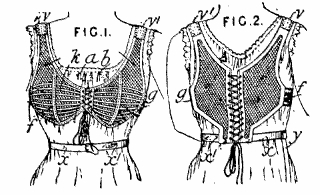Copyright © Françoise Herrmann
In 1998, Sara Blakely is purported to have cut off the feet on a pair of pantyhose for a smooth and tight look under a pair of white pants and the freedom to wear open-toe sandals to match. An idea that she then patented, and successfully marketed into a billion-dollar business called Spanx®. Thus, with a single control top, body smoothing and footless pantyhose product, the shapewear industry was re-born, providing women with a whole line of new and comfortable undergarments that support and lift, while offering the desirable aesthetics of “smooth” body contours. A shapewear line that also diversified to such products as bodysuits, slips, high-waisted shorts, camis, tanks and shaping thongs, boyshorts and briefs, while also expanding to include specific undergarments for Mamas during pregnancy, and more recently undergarrments for men,
 Add crimson packaging for the fine line of super comfortable body shaping products with cartoon characters featuring Sara Blakely, in a world of nudes, beige and blush, and the spectacular story of Spanx® also documents itself.
Add crimson packaging for the fine line of super comfortable body shaping products with cartoon characters featuring Sara Blakely, in a world of nudes, beige and blush, and the spectacular story of Spanx® also documents itself.
In 2012, the founder and inventor of the original product, Sara Blakely, was named the world’s youngest, self-made female billionaire by Forbes Magazine and one of TIME’s 100 Most Influential people.
The following is a list of the Spanx® US utility and design patent applications, and granted patents, including a WIPO patent. These patents cover both the Spanx® garments and Spanx® product display systems. Many more Spanx® patent family members have been filed at the European Patent Office, and at the national patent offices of Australia, Canada, Austria, Germany and elsewhere.
- US2001035032 (A1) ― 2001-11-01 - Pantyhose under garment
- US2003196252 (A1) ― 2003-10-23 - Two-ply body-smoothing undergarment
- US2016206012 (A1) ― 2016-07-21 - Abdominal-restraint garment and methods of assembling the same
- USD760471 (S) ― 2016-07-05 - Garment
- US9320366 (B1) ― 2016-04-26 - Product storage unit and method of arrangement
- US2015342265 (A1) ― 2015-12-03 - Flocked shapewear garments
- USD741631 (S) ― 2015-10-27 - Display tower
- USD733994 (S1) ― 2015-07-14 - Garment
- US2015255011 (A1) ― 2015-09-10 - Display Fixture
- USD724874 (S) ― 2015-03-24 - Multi-faceted display tower
- US2014317823 (A1) ― 2014-10-30 - Reversible Compression Garments and Methods of Assembling and Using Same
- US2014273742 (A1) ― 2014-09-18 - Posterior-Lifting Garment and Methods of Assembling The Same
- US2014273741 (A1) ― 2014-09-18 - Abdominal-restraint garment and methods of assembling the same
- USD707920 (S) ― 2014-07-01 - Garment
- US2008127683 (A1) ― 2008-06-05 - Tubular knit bra
- US2007199134 (A1) ― 2007-08-30 - Hosiery Garment and Method of Making the Same
- WO0176398 (A2) ― 2001-10-18 - A pantyhose undergarment and method for manufacturing
References
Spanx®










